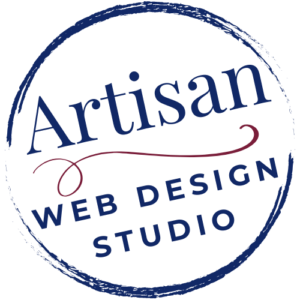Creativity Meets Strategy: The Secret to Successful Websites for Creative Professionals
As a creative professional, you thrive on vision, artistry, and storytelling. Whether you’re a designer, photographer, writer, or artist, your work reflects emotion, beauty, and originality.
But building a website that not only looks stunning but also works strategically? That’s a different challenge. Many creatives struggle with things like usability, conversions, and technical performance.
This is where a logical website designer becomes a vital partner. Research shows that diverse teams, especially those combining creativity with analytical thinking, make better decisions and solve problems more effectively (Page, 2007). When you team up with someone who brings structure and strategy, your creative vision turns into a high-performing website that engages visitors and supports real business growth.
First impressions matter. According to Google research, users form an opinion of a website in under 50 milliseconds. Although looks matter, clarity and usability are what keep visitors around.
The Hidden Pitfall: When Creativity Overpowers Functionality
Creative professionals often focus so much on visual appeal that they overlook usability. Unfortunately, a beautiful website that’s hard to navigate won’t convert visitors.
Here are some common issues:
- Confusing navigation – For example, users will leave within 10–20 seconds if they can’t find what they need (Nielsen Norman Group).
- Weak calls to action – In fact, a great-looking site is useless if it doesn’t guide users to act. Clear CTAs can increase conversions by up to 121% (WordStream).
- Slow loading times – Additionally, large images or excessive animations hurt performance. Google PageSpeed Insights reports that 53% of users leave if a site takes more than three seconds to load.
- Mobile design issues – Moreover, over 60% of web traffic is mobile. Sites that aren’t mobile-friendly risk losing the majority of their audience.
💡 Expert Insight: A logical designer balances beauty with structure. Their approach results in intuitive navigation, fast load times, and clean layouts. Studies also show that teams combining creative and analytical skills make smarter, data-driven decisions (Chiu, 2011).
Strategy First: Why UX and Conversion-Focused Design Matter
A website isn’t just a digital portfolio. Instead, it’s a tool to grow your business. To turn visitors into clients, your site must be more than beautiful. Explore our web design services to see how strategy drives results.
- Have a clear layout that guides users naturally
- Communicate your message instantly
- Use design features that prompt action
A Stanford University study found that 75% of people judge a brand’s credibility based on its website. If your site feels confusing or hard to use, potential clients will look elsewhere.
💡 Expert Insight: Logical designers use behavior research and conversion psychology to make sure your site works—not just looks good. They know where to place CTAs, how to structure content, and how to keep users engaged.
SEO & Technical Structure: The Missing Link
If your site can’t be found, it won’t grow your business. Unfortunately, many creatives unintentionally hurt their visibility by ignoring technical details:
- SEO basics – These include missing meta descriptions, poor headers, and no keywords.
- Site speed – Likewise, uncompressed images and unnecessary plugins slow everything down.
- Security – Without SSL or regular updates, your site becomes vulnerable.
- Accessibility – Failing to follow ADA or WCAG guidelines could exclude users and even result in legal risk.
💡 Expert Insight: A logical website designer ensures your site is SEO-ready, secure, fast-loading, and accessible. These things aren’t just technical—they affect your reach, trust, and results.
The Perfect Partnership: Creativity + Logic
Don’t think of logic and creativity as opposites. Instead, see them as a perfect match that forms the foundation of a successful digital presence.
- 🎨 Creative Vision – Your unique artistic style draws people in.
- 📊 Strategic Execution – Logical design makes your site usable, findable, and persuasive.
💡 Expert Insight: Research shows that businesses blending creative and analytical thinking see better innovation, efficiency, and growth (Chiu, 2011).
Final Thoughts: Why Artisan Web Design Studio Is Built for You
At Artisan Web Design Studio, I work closely with creative professionals who need a site that blends beauty with strategy.
✔ I handle structure, logic, and performance while you focus on creativity.
✔ I optimize for speed, SEO, and conversions so your site works for you.
✔ I provide ongoing hosting and support so your site stays secure and updated.
🚀 Ready to level up your online presence? Book a free consultation and find out how strategic design can elevate your creative business.
📩 phennessey@artisanwebdesignstudio.com | 🌐 https://artisanwebdesignstudio.com/
References
Tuch, A. N., Presslaber, E. E., Stöcklin, M., Opwis, K., & Bargas-Avila, J. A. (2012). The role of visual complexity and prototypicality regarding first impression of websites: Working towards understanding aesthetic judgments. International Journal of Human-Computer Studies, 70(11), 794–811. https://www.sciencedirect.com/science/article/abs/pii/S1071581912001127
Fessenden, T. (2017). First impressions matter: How designers can support humans’ automatic cognitive processing. Nielsen Norman Group. https://www.nngroup.com/articles/first-impressions-human-automaticity/
Stanford Web Credibility Research. (n.d.). Stanford University. https://credibility.stanford.edu/
Google. (n.d.). PageSpeed Insights. Google Developers. https://pagespeed.web.dev/
Guo, Q., & Agichtein, E. (2010). Ready to buy or just browsing? Detecting web searcher intent using session features. Proceedings of the 33rd International ACM SIGIR Conference on Research and Development in Information Retrieval, 130–137. https://www.microsoft.com/en-us/research/publication/ready-to-buy-or-just-browsing-detecting-web-searcher-intent-using-session-features/
Page, S. E. (2007). The difference: How the power of diversity creates better groups, firms, schools, and societies. Princeton University Press.
Chiu, M. M. (2011). Multidisciplinary collaboration: Research results from business and education settings. Perspectives on Psychological Science, 6(3), 284–287. https://doi.org/10.1177/1745691611400234

